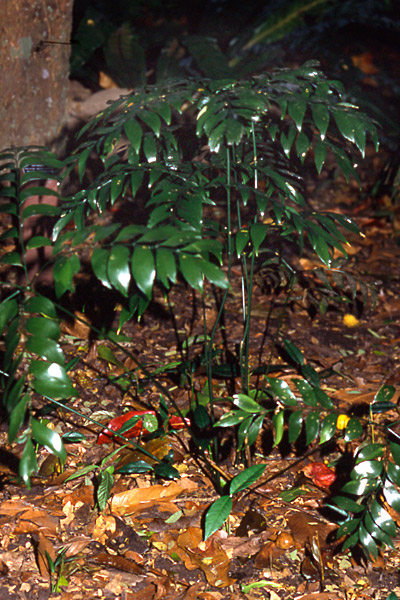|
[Front Page] [Features] [Departments] [Society Home] [Subscribe]

The Byfield Fern: Bowenia
Leonard P. Butt
Of all the many variable cycads, the genus Bowenia holds a lot of interest. Named for the first Governor of Queensland, Sir George Ferguson Bowen, it was first described in 1863 by the younger of the English botanists, Joseph Dalton Hooker.
The leaves are extremely fem-like, so much so that they have been used for decorative purposes such as on the back walls of butcher shops or backing material for cut flowers and wreaths for many years. They have long-lasting fronds, even out of water, and are popular for the ever fresh green appearance.
The best known, Bowenia serrulata (W. Bull) C. Chamberlain, is attributed to Joseph Chamberlain after his visit to Australia in the early 20th century.
| |
 |
| |
Bowenia spectabilis |
To date, the genus Bowenia has only two described species, B.serrulata and the very tropical growing B.spectabilis. Leaf shape is extremely variable in both species. The species around Tinaroo, north Queensland, and again in parts of the Daintree have so many dissimilar parts that I feel they warrant being described as further species.
L.A.S. Johnson, in describing the genus (1959), stated that it possessed more advanced features than any other Australian species and is quite distinctly different to any other. Latest information is that Bowenia has been further examined and placed in another family other than Zamiaceae. This is the best news yet and entirely warranted. What is very distinctive in the Bowenia is that the rachis branches. This does not occur in other genera within the Zamiaceae family.
In both instances when I viewed Bowenia spectabilis at Paronella Park, north Queensland, and B.serrulata at Stoney Creek, south-west of Byfield, the plants were mature and extremely large.
The B.spectabilis fronds appeared at least 1.5 metres long, petioles seven in number, each rachis branching dichotomously. Some had seven branchlets, all with shiny green entire pinnules in a bipinnatifid semi-circular fan. There were many seedlings in Paronella Park. Although there were a few male cones around the plant caudices, a large number of female cones, some splitting open to display purplish ovules, were evident on the edges of a lawn area near mature plants.
At Stoney Creek, B.serrulata was found growing in a Pinus plantation. The petiole and rachis was up to two metres long and the same form of rachis branching was observed. Seed ovules, apparently cleaned by animals, were abundant around the plants.
Because these plants, like much of our indigenous flora, are very variable, when Hooker received the form of B.serrulata that occurs on the Atherton Tableland when he did his studies with what he believed was a monotypic B.spectabilis, he mentioned it merely as a variety of B.spectabilis.
Apart from the entire pinnules of B.spectabilis and the serrate margined ones of B.serrulata, other differences are profound. The caudex of B.spectabilis and other forms around it are elongate and rather turnip-shaped, differing considerably from the ovate, nearly globose, caudex of B.serrulata, regardless of where they are found. One form found around the Daintree area is serrated around the upper parts of the pinnule and entire along the base of it. Just another reason why the genus Bowenia deserves much more research.
The poisonous substance, macrozamin, which is a defence mechanism in all zamiads, also occurs in the Bowenia. As its habitat is not used by commercial livestock, as is the Cycas etc., it is not really a worry.
Considering how the exotic cycad, Zamia furfuracea, has rapidly gained popularity here in Queensland, it stands to reason that, given the right publicity, seed-grown Bowenia could fill the same horticultural role. They do very well in cultivation in tropical areas and can be grown as a very attractive potted plant, maturing to cone-bearing capacity in a few years.
In Brisbane I have several plants, mostly B.serrulata, growing in my garden quite successfully, mostly in mottled sunlight. Some are in 200 mm containers with their fronds up to 1 metre long. I find that a good sandy loam, augmented with humus, does best as a growing mixture. Scale insects of a dark hard-shelled variety seem to be the only trouble. Although diluted agricultural oil will eradicate them, a better method is to keep a vigil for their ant hosts and spray these with pyrethrum.
Forestry sections now regularly collect B.serrulata ovules, and seedlings are available from nursery sources. This only came about because I harassed Forestry authorities for about ten years as a Forestry worker and teacher for TAFE. Finally collections were started.
It is to be hoped that this beautiful Australian cycad will eventually become a cultivated garden plant in all its forms.
From SGAP Queensland "Bulletin", December 1997.

[Front Page] [Features] [Departments] [Society Home] [Subscribe]
Australian Plants online - September 2004
Association of Societies for Growing Australian Plants
|